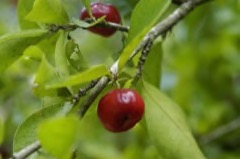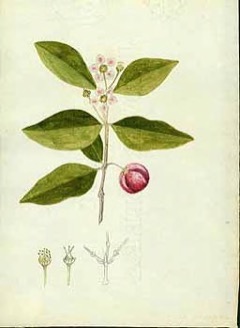 |
|
CostaPPPR wikimedia.org |
 |
| http://www.edibleplants.org |
Translate this page:
Summary
Malpighia emarginata or also known in various names such as acerola, Barbados cherry, West Indian cherry, and wild crepe myrtle is an evergreen shrub or small tree with a short bole and spreading branches. It usually grows about 2-3 m in height. The branches are brittle. The leaves are simple ovate-lanceolate, opposite, and with small hairs. The flowers are bisexual with five pink or red petals. The fruits are bright red drupes, juicy, and has high vitamin C content making the fruits taste sour. The fruits are edible, usually eaten raw but also made into juices, baby food, jam, etc. Acerola is native to South America, southern Mexico, Puerto Rico, Brazil, and Central America. It is also grown as ornaments and for hedges.
Physical Characteristics

 Malpighia emarginata is an evergreen Shrub growing to 4 m (13ft) by 4 m (13ft) at a medium rate.
Malpighia emarginata is an evergreen Shrub growing to 4 m (13ft) by 4 m (13ft) at a medium rate.
See above for USDA hardiness. It is hardy to UK zone 10 and is frost tender.
It is noted for attracting wildlife.
Suitable for: light (sandy), medium (loamy) and heavy (clay) soils and prefers well-drained soil. Suitable pH: mildly acid and neutral soils and can grow in very acid and saline soils.
It can grow in semi-shade (light woodland) or no shade. It prefers moist soil and can tolerate drought. The plant can tolerates strong winds but not maritime exposure.
UK Hardiness Map
US Hardiness Map
Synonyms
Malpighia berteroana Spreng. Malpighia glabra Hort. Malpighia lanceolata Griseb. Malpighia punicifol
Plant Habitats
Edible Uses
Edible Parts: Fruit
Edible Uses: Drink
Fruit - raw or cooked[301 ]. The bright red fruit can range in flavour from sweet to somewhat acid[296 , 301 ]. As well as being eaten out of hand, they can also be stewed, made into juices, sauces, jellies, jams, wines or purees[301 , 317 ]. The fruits are very rich in vitamin C (1 - 4 g per 100 g juice)[296 , 317 ]. They are widely used in the preparation of vitamin tablets and other nutritional supplements[301 ]. The juice is added to other juices in order to improve their nutritional value[317 ]. Plants can produce 2 - 3 crops of fruit a year[296 ].
References More on Edible Uses
Medicinal Uses
Plants For A Future can not take any responsibility for any adverse effects from the use of plants. Always seek advice from a professional before using a plant medicinally.
Dysentery Vitamin C
The fruits are considered beneficial against liver problems, diarrhoea, dysentery, coughs and colds[303 ]. The bark exudes a gum that is recommended as a pectoral[348 ]. Known historically as a natural source of ascorbic acid (Vitamin C). Ascorbic acid levels in fresh acerola fruit are in the range of 1.5 to 4% by weight. A glass of acerola juice (180-ml) contains 35mg/ml of ascorbic acid the same as 14 litres of orange Juice.
References More on Medicinal Uses
The Bookshop: Edible Plant Books
Our Latest books on Perennial Plants For Food Forests and Permaculture Gardens in paperback or digital formats.

Edible Tropical Plants
Food Forest Plants for Hotter Conditions: 250+ Plants For Tropical Food Forests & Permaculture Gardens.
More

Edible Temperate Plants
Plants for Your Food Forest: 500 Plants for Temperate Food Forests & Permaculture Gardens.
More

More Books
PFAF have eight books available in paperback and digital formats. Browse the shop for more information.
Shop Now
Other Uses
Agroforestry Uses: Grown as an edible hedge[317 ].
Special Uses
Food Forest
References More on Other Uses
Cultivation details
Easily grown in good soil and a sunny position[296 ]. Seedlings can fruit when only 2 - 3 years old but are not always of as good quality as their parents[296 ]. Flowering Time: Mid-Spring, Late Spring/Early Summer. Bloom Color: Pink. Spacing: 15-18 in. (38-45 cm) 18-24 in. (45-60 cm) 24-36 in. (60-90 cm) 36-48 in. (90-120 cm) 4-6 ft. (1.2-1.8 m) 6-8 ft. (1.8-2.4 m). Dwarf varieties are available with a compact habit growing to approx 1.5m (5ft).
References Carbon Farming Information and Carbon Sequestration Information
Temperature Converter
Type a value in the Celsius field to convert the value to Fahrenheit:
Fahrenheit:
The PFAF Bookshop
Plants For A Future have a number of books available in paperback and digital form. Book titles include Edible Plants, Edible Perennials, Edible Trees,Edible Shrubs, Woodland Gardening, and Temperate Food Forest Plants. Our new book is Food Forest Plants For Hotter Conditions (Tropical and Sub-Tropical).
Shop Now
Plant Propagation
Seed - Cuttings
Other Names
If available other names are mentioned here
Acerola, Barbados Cherry, West Indian Cherry, Wild Crapemyrtle, Cereza,
Native Range
NORTHERN AMERICA: Mexico, Guerrero, Oaxaca, Yucatán, SOUTHERN AMERICA: Belize, Guatemala, French Guiana, Venezuela, Colombia, Ecuador,
Weed Potential
Right plant wrong place. We are currently updating this section.
Please note that a plant may be invasive in one area but may not in your area so it's worth checking.
Conservation Status
IUCN Red List of Threatened Plants Status : This taxon has not yet been assessed

Growth: S = slow M = medium F = fast. Soil: L = light (sandy) M = medium H = heavy (clay). pH: A = acid N = neutral B = basic (alkaline). Shade: F = full shade S = semi-shade N = no shade. Moisture: D = dry M = Moist We = wet Wa = water.
Now available:
Food Forest Plants for Mediterranean Conditions
350+ Perennial Plants For Mediterranean and Drier Food Forests and Permaculture Gardens.
[Paperback and eBook]
This is the third in Plants For A Future's series of plant guides for food forests tailored to
specific climate zones. Following volumes on temperate and tropical ecosystems, this book focuses
on species suited to Mediterranean conditions—regions with hot, dry summers and cool, wet winters,
often facing the added challenge of climate change.
Read More
Expert comment
Author
DC.
Botanical References
Links / References
For a list of references used on this page please go here
A special thanks to Ken Fern for some of the information used on this page.
Readers comment
| Add a comment |
|
If you have important information about this plant that may help other users please add a comment or link below. Only comments or links that are felt to be directly relevant to a plant will be included. If you think a comment/link or information contained on this page is inaccurate or misleading we would welcome your feedback at [email protected]. If you have questions about a plant please use the Forum on this website as we do not have the resources to answer questions ourselves.
* Please note: the comments by website users are not necessarily those held by PFAF and may give misleading or inaccurate information.
To leave a comment please Register or login here All comments need to be approved so will not appear immediately.
|
Subject : Malpighia emarginata
|
|
|
|